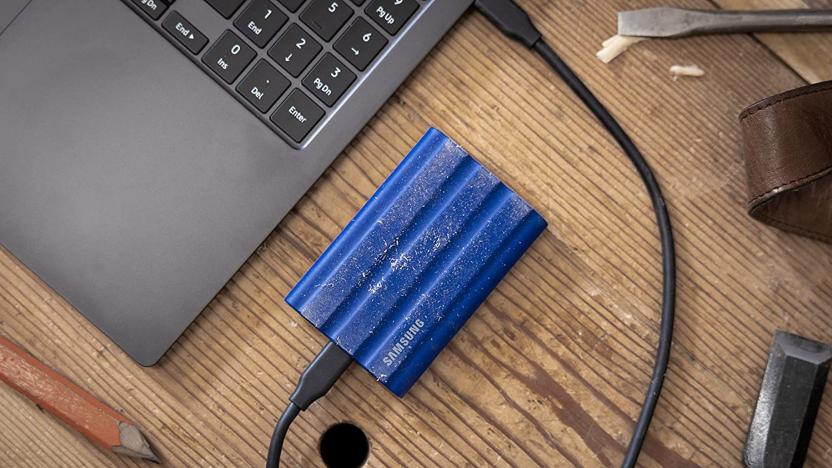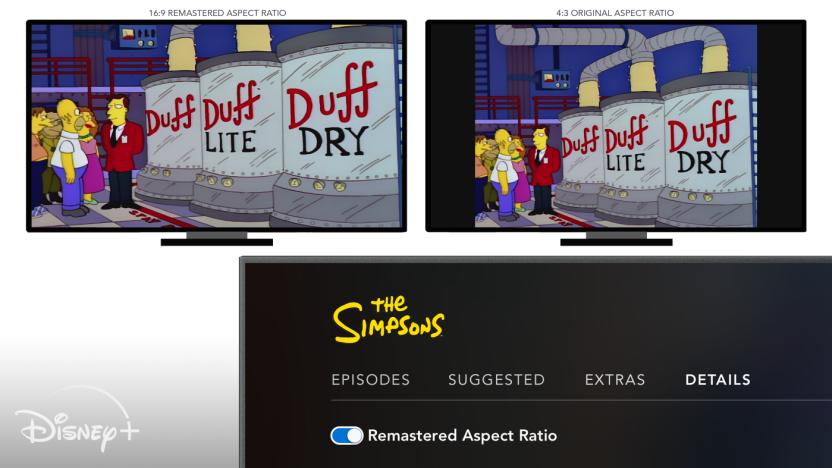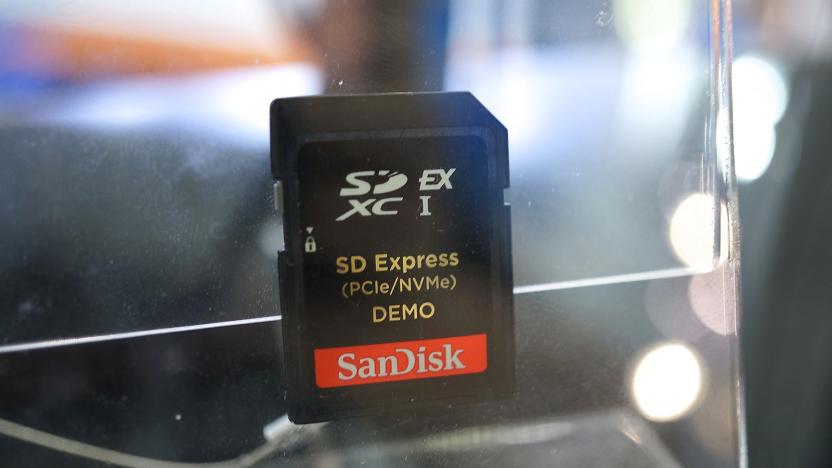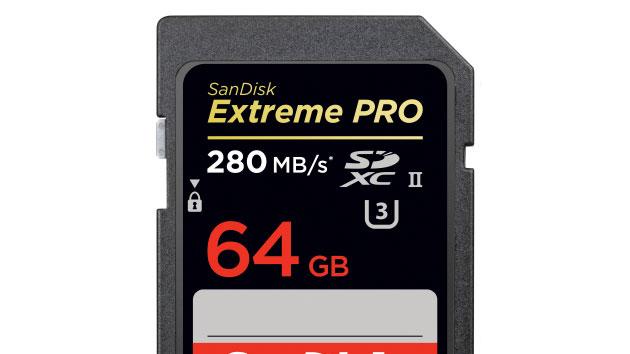sd
Latest

Samsung SSDs and memory cards are up to 50 percent off
Its PRO Plus 512GB MicroSD is down 42 percent, for instance.

At last, you can watch early ‘Simpsons’ episodes as intended on Disney+
As promised, 'Simpsons' fans can now watch early seasons (pre-2009) in 4:3 format on Disney+.

Adobe Lightroom's direct import feature comes to iPhone and iPad
iOS Lightroom users rejoice, the long-awaited direct import feature is finally available. As of today, you'll be able to import photos directly from an SD card or USB drive into Lightroom iOS and iPadOS, instead of using the previously time-consuming workaround of importing images to camera roll and then copying them over to Lightroom's library.

Sony says its USB hub is the world's fastest SD card reader
It's hard to spice up USB hubs when they're practically ubiquitous. Sony's solution? Make it indispensable to pro photographers. The company's newly announced MRW-W3 hub is billed as the "world's fastest" UHS-II SD (and microSD) card reader, supporting read rates up to 300MB/s. Whether or not it lives up to the boasts, it should easily transfer your camera's giant RAW photos and 4K videos. This isn't a one-trick brick, either -- it's meant to handle many of your laptop's other needs while you're on the road.

You may soon store your entire media collection on one SD card
A single SD card might someday be enough to hold your entire media collection, no matter how huge it is; and it'll obviously be even faster than today's offerings. The SD Association (the group that sets memory card standards) just announced a new specification called SD Express, which adds PCI Express and NVMe interfaces to the cards, thus ramping up data transfer speeds to as much as 985MB per second -- almost doubling that of last year's SSDs. This spec can be applied to future SDXC and SDHC memory cards, but it'll require the same additional pins as UHS-II and UHS-III specs to support the extra bandwidth.

SanDisk’s 'Industrial' SD cards can withstand extreme temperatures
Western Digital is working on a new line of SanDisk memory cards that can withstand a wide range of temperatures, from the extremely hot to the extremely cold, AnandTech reports. The lineup includes an Automotive SD meant for vehicles like cars and drones and three Industrial cards -- Industrial SD, Industrial microSD and Industrial XI -- intended for more mainstream industrial applications.

SanDisk outs the 'world's first' 1TB SD card
If you handle a lot of 4K video, you'll know that most available SD cards will struggle to handle all of your high-quality footage. The two-year old SanDisk 512GB SD card might take the edge off somewhat, but that isn't all that Western Digital, owner of the SanDisk brand, has got to offer. Today, the storage giant unveiled what it calls the "world's first" 1TB SD card. It's only a prototype, but already the company is touting the card's ability to adequately handle 4K, 8K, VR and 360-degree video when it officially becomes available.

SanDisk's 512GB SD card will hold all the 4K video you can handle
If you've been dabbling in 4K video recording, you probably know that most SD cards won't cut it; you'll be thankful if you have enough space for a wedding video, let alone a magnum opus. SanDisk may have a solution for that space problem in its new, extra-capacious 512GB Extreme Pro SDXC card. It's fast enough (95MB/s) to shoot interruption-free 4K, but also has more than enough storage for a day's worth of movies and high-speed photography. Capture 60Mbps video on Sony's AX100, for example, and you could theoretically keep going for almost 19 hours. You're going to pay dearly for all that headroom, though. The 512GB card sells for a whopping $800 -- unless video production is your bread and butter, you're probably better off "settling" for the Extreme Pro's 128GB or 256GB variants.

SanDisk's latest flagship SD card supports extremely fast write speeds, 4K video
With affordable 4K cameras from Panasonic and Sony set to ship soon, it's time for flash memory manufacturers to begin readying stockpiles of high-speed SD cards. Today, SanDisk is announcing its latest flagship, the Extreme Pro SDHC/SDXC UHS-II. It exceeds the new UHS Speed Class (U3) spec, supporting continuous write speeds of up to 250MB/s. While the card is most appropriate for folks shooting 4K video, it'll also come in handy when you're snapping continuous RAW stills at high frame rates, letting you unload the camera's buffer just as quickly as you can fill it. The new cards will ship in April in 16GB to 64GB capacities, with prices ranging from $120 to $300. There's also a new U3 card reader that's designed to let you take full advantage of the SDXC card's 280MB/s transfer speeds. That device will also be available in April, with a $50 MSRP. Update: The card supports a 250MB/s write speed, as originally reported. The read speed measures 280MB/s.

Netflix intros cheaper standard definition streaming plan for new subscribers
If you consider yourself both extremely frugal and averse to the luxuries of seeing Hollywood eye candy actors in Super HD, Netflix's new SD tier could be right up your alley. The streaming service has begun offering a low-end plan for new subscribers only that'll allow standard definition streaming to one device -- that's right, no simultaneous viewing -- for $6.99 per month. We can confirm the plan is indeed now live as it appeared when we attempted to sign up for new service though, as TechCrunch reports, that may not be the case for everyone. Take note, this recent plan addition is only $1 cheaper than the basic HD tier that lets users stream to two devices at once, making the SD plan's cost benefit a bit dubious. So, if you're really counting your pennies and haven't bothered to upgrade to an HD-capable TV or tablet or phone (which makes us wonder if you even have broadband), then by all means, have at this promo. You're also probably not into account sharing anyway. And really, that's what that extra $1/mo is for, right? Right.

New SD card format is speedy enough for 4K video
Outside of a few smartphones, 4K video capture has largely been limited to pro-level hardware; the SD cards in regular cameras frequently can't handle so many pixels at once. That won't be a problem in the near future, as the SD Association has just unveiled an Ultra High Speed Class 3 (U3) card format that's up to the job. The spec guarantees write performance of at least 30 MB/s, or enough bandwidth to record 4K clips without hiccups. You'll have to wait for U3-capable devices and cards to begin shooting, but it shouldn't be long before you can produce footage worthy of your Ultra HD TV.

Toshiba's Exceria Pro SDHC cards claim 'world's fastest' write speeds of 240MB per second
SD cards are a dime a dozen, so any new entrants need a pretty juicy hook to get our ears pricked. Toshiba's Exceria Pro cards mightn't have any wireless or special transfer features, but they do claim to take the "world's fastest" title for one basic spec: write speeds. Intended for top-level cameras, the Pro SDHC cards will come in 16GB and 32GB configurations and tout the UHS-II high-speed standard for achieving write speeds of 240MB per second. Launching alongside the Pro options will be a couple of Exceria SDXC cards with capacities of 32GB or 64GB. Also UHS-II compliant, these have maximum write speeds of 120MB per second; data read speeds of all Exceria cards top out at 260MB per second. They'll be available in "major markets worldwide," but will arrive in Japan first, with the Pro cards launching in October before the regular Exceria models in November. Pricing info isn't available right now, but we imagine they'll be a little more expensive than the standard cards tucked away in your point-and-shoot.

Apple patent stuffs two ports into one, saves space in your laptop
Port space is very limited on laptops, but Apple has just received a patent that could solve that problem in the simplest way possible: cramming two ports into one. Expanding on what we've seen with some multi-format card readers, Apple has designed a layered port whose staggered electrical contacts and overall shape let it accept two different connectors. While the company uses the combination of a USB port and SD card reader as its example, the patent could theoretically apply to any two technologies that make sense together. The real question is whether or not Apple will use its invention at all. The Mac maker has a few slim portables that could use some expansion, but there's no evidence that the company will tweak its computer designs in the near future.

SD Association adds secure NFC support to its smartSD memory cards
Though companies like Visa and Device Fidelity have already come up with a way to make NFC payments via microSD card, the SD Association (the standardization body for SD cards) has introduced a spec that opens up that ability to others. It essentially adds the single wire protocol (SWP) as a Secure Element to enable NFC authorizations like mobile payments and identity verification. Now that any of its members can implement the standard to their microSD cards, perhaps some day we can truly replace our wallets with our phones. We've included the press release and a short video demo after the break if you feel like understanding the tech a little better.

Eye-Fi's Mobi SD card sends images straight to a phone or tablet
When Eye-Fi first launched its wireless SD cards back in 2006, most of us weren't carrying smartphones, much less tablets. At the time, the idea was to send your photos straight from your camera to your PC, where you could run slideshows or upload them to the cloud (if you were already into that sort of thing). Lately, though, Eye-Fi has been forced to rethink its product: the company just announced the Mobi, a $50 Class 10 card that sends images directly to your mobile device, bypassing the computer altogether. Designed for people already used to storing pics on phones and tablets, it works with a free iOS / Android app that acts as an image viewer. To set it up, you enter a 10-digit activation code included in the packaging, which you can use with as many gadgets as you like. After that, the card will continuously send photos and video to your device. And because the Mobi is a hotspot unto itself, your gear doesn't all need to be on the same network, or even in range of a router. The Mobi is available today, priced at $50 for 8GB and $80 for 16GB. For those of you who expect to do some heavy-duty editing, you can still buy Eye-Fi's existing X2 cards, which send images to PCs, and can handle both RAW and JPEG. Additionally, those pro-level cards can be configured to send different file formats to different locations. If that seems like overkill, though, the Mobi might be the better option -- it's not like you can't eventually get those photos off your phone, right?

Humax's take on an IP-connected TV box for Comcast passes through the FCC
Comcast isn't opening up its set-top boxes (UI and all) in the way we'd like, but it has established a reference spec (RDK) for potential hardware partners to build their own versions of its next generation setup. As reported by Light Reading, Cisco, Humax, Pace, Technicolor and others are working on hardware for a new multiroom setup based on a central gateway (or maybe a Cablevision-style network DVR) that streams video to IP-connected extenders called the XI3. Now Humax's Xfinity-branded XI3-H has been revealed in an FCC filing spotted by Wireless Goodness. It sports a coax in/out connection for MoCA and TV, HDMI in and out, Ethernet and a USB port for a WiFi adapter. There's also an SD card slot interestingly, which could potentially be used as local DVR storage for quick pause and rewind without pulling from the main server.

Samsung brings speedy UHS-I class SD and microSD memory cards in new 64GB sizes to IFA 2012
We've seen UHS-I class SD and microSD cards capable of incredible speeds before, and Samsung unveiled a few 16GB microSD modules of its own earlier this year, but now it's showing off 64GB sized versions at IFA 2012. The top of the line Pro editions intended for high speed LTE-connected phones and tablets are capable of read/write speeds at 80MB/40MB per second (SD) and 70MB/20MB per second (microSD). If you're not with us in Germany, you should be able to get your hands on them in mid-October.

Panasonic preps SD cards that survive heat, water and X-rays, will probably outlast you
Much ado has been made of weather-resistant cameras, but it's all a moot point if the memory card dies, isn't it? Panasonic wants that level of survivability in its SDHC and SDXC cards, and its new UHS-I-level SDAB and SDUB lines are tested for the kind of abuse that could see the camera give up the ghost first. The cards can take the kinds of punishment that we often associate with rugged gear, such as temperatures from -13F to 185F, immersion in 3.3 feet of water for half an hour and the usual steep drops. It's beyond this that the resistance levels become truly exotic: the cards are also built to survive zaps of electricity, proximity to magnets and exposure to X-rays. If it all becomes too much to bear, the design will even fuse on the inside to prevent fire burning the card from within. Those who like what they see will only have to decide whether or not they want the SDAB range's 95MB/s read speeds and 80MB/s writes or are willing to settle for the SDUB line's respective 90MB/s and 45MB/s transfers. We have yet to see if or when the SD cards cross the Pacific after their September 8th launch in Japan, although we hope so -- with that kind of extra-tough design, our photos are more likely to endure than we will.

Windows Phone 8 to support multi-core CPUs, HD resolutions, SD cards and NFC
Microsoft is on stage at the Windows Phone Developer Summit offering us a bite of what's to come in Windows Phone 8, and one of the tastiest morsels may just be the noticeably more diverse hardware it will support. The new platform won't just support dual-core processors -- it will support as many as 64 cores, should such massively parallel chips come to exist in the platform's lifetime. Also gone is that long-criticized 800 x 480 display resolution ceiling: if phone builders like, they can either opt for the increasingly common 1280 x 720 or a rarer 1280 x 768. A few subtler feature parities are coming with the upgrade, such as NFC for tags and payments as well as a long, long requested support for SD cards beyond the crude initial expansion. All told, Microsoft just brought Windows Phone right up to hardware parity with its biggest rivals, and possibly a bit beyond. To check out the latest updates from Microsoft's Windows Phone event, visit our liveblog! %Gallery-158713%

Hands-on with the Electric Imp at Maker Faire (video)
Yesterday at Maker Faire Bay Area 2012 we visited the Electric Imp booth to chat with the startup's founders and get some hands-on time with the tiny wireless computer. What is the Electric Imp? It's a module containing an ARM Cortex M3 SoC with embedded WiFi that's built into an SD card form factor. While the device looks just like and SD card, it's not pin-compatible with the standard -- the idea is to leverage a reliable and affordable connector for the Electric Imp. The module is not very useful on its own -- it only comes to life when inserted into one of several boards, which provide the Electric Imp with power and access to the real world. In turn the device gives these boards a brain and an Internet connection. Eventually the company hopes that appliance manufacturers will incorporate Electric Imp slots into products to make them network aware. We talked with CEO Hugo Fiennes (formerly with Apple) about the past, present and future of the Electric Imp so hit the break to read more and to watch our hands-on video.%Gallery-155789%













